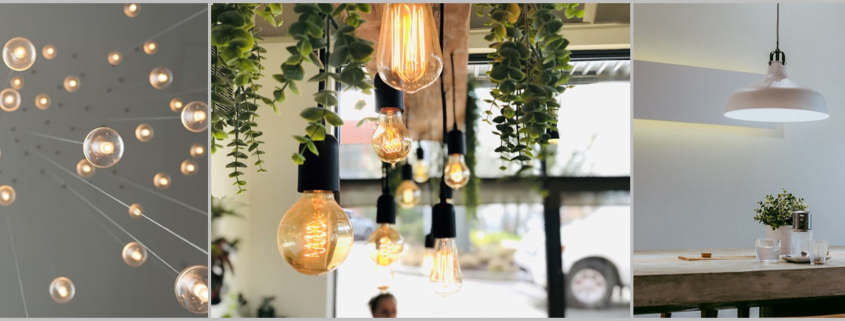Everything On Lighting From Wiring to Home Decor
Everything On Lighting From Wiring to Home Decor
Lights are, ideally, aspects of a home that always work. Hit the switch, and the darkness vanishes. Because of this, it’s a common mistake to overlook having your wiring and lighting inspected before purchasing a home or embarking on an extensive renovation.
Shed some light on the subject
Before buying, you must ensure everything is up to code with a lighting inspection. Some homes have severely outdated wiring, and unseen wiring issues can cause fires. Lights are more than a simple switch and the wiring hiding behind them.
There are many types of lighting, and each changes a room considerably. This guide goes over the benefits and disadvantages of these and how a space can shine or dull depending on the lights chosen. Before installing those lights, have you considered all the factors involved, such as sustainability? We’ll go over everything you need to know.
Types of lighting and lights
The way lighting is spoken about can seem odd, but there’s some easy way to make sense of it. A light provides lighting. There are three types of lighting: general lighting, accent lighting, and task lighting.
General lighting is turning on a switch, and the light on the ceiling brightens the room — not a specific section of the room, but the whole room. This is why it’s called ‘general.’ It’s also known as ambient lighting.
Accent lighting only lights up a specific section of a room. For this, consider a bedside reading lamp or a light that hangs over a dining table.
Finally, task lighting is specific lights to accomplish tasks. This could be the light above the stove or the vanity light for makeup. A single light can belong to multiple types.
Different types of lights or lamps in a lighting system
An incandescent lamp (or bulb) produces light by heating a filament. When you think of inventing a lightbulb, this was the bulb. They are cheap, and you can dim them, but they also are highly inefficient. Much of their energy (wattage) is turned into heat. They last roughly 1000 hours, which is short in comparison to others.
The compact fluorescent light is the standard replacement for incandescent. They’re more energy-efficient and can burn for nearly 8000 hours. You can get them in a range of color temperatures (which we’ll explain below), making them quite flexible. It’s not usually dimmable and requires mercury to work, so be sure to recycle them properly.
Halogen lamps work similarly to incandescent in that they use heat. The difference is halogen gas is the key component of this bulb, and it prevents the surrounding glass from dimming over time. This type of light is usually much brighter and much hotter to the touch.
Metal halide lights may sound unfamiliar, but you’ve seen them in many places. They’re usually large lights, and they are often used for parking lots and ballparks because they’re known for such a bright, high output. These can take 15 minutes to fully warm up after being switched on.
You may know the light-emitting diode by its acronym: the LED. These are efficiency masters, lasting 25,000 hours to start. They can be dimmed, and they are the most expensive lightbulb for basic household use, but they make up for it with sheer energy savings over time.
Fluorescent tubes are inexpensive. They live long and have decent energy efficiency. This is why you see them everywhere, especially in commercial buildings. Any fluorescent light requires mercury, so disposing of them needs care and consideration.
Neon lights are the brightly colored, humming lights that indicate whether a shop is open or not. Neon is excellent if you want a specific color of light, and because of its tube shape, it is used for a lot of signage. While we call all lights of this variety ‘neon,’ — different colors use different gasses to work. If it’s red, it’s neon.
High-intensity discharge lamps are used where one needs the most light per watt possible. These lights are seen above the gas pumps. They take a while to turn on and are inflexible for what colors or warmth they can produce.
Low-Pressure Sodium lights use all of their energy for light rather than heat. They produce a soft yellow color and are most commonly used as outdoor lighting in Europe. As the name implies, it uses sodium and can take some time to warm up. It is considered to be the worst color rendering of all the lamps.
Ambient indoor lighting, outdoor lighting, task lighting, accent lighting
Ambient, or general lighting, serves as the main light source for a room. The best ambient lighting opts for minimal glare within a comfortable illumination level. Ideally, there should be no dark corners if the ambient light is placed correctly. Many fixtures help create this light, such as a chandelier, flush mount lights that hug the ceiling, and recessed lights, which illuminate a lot of space and have a slight, simple aesthetic. Another classic choice would be a ceiling fan.
Accent lighting is for specific sections of a room. Perhaps you have track lighting, a track of lights running parallel to a fireplace. When you turn those on, it lights that area up and directs the eye. It accents the fireplace nicely. Vanity lights for mirrors are very useful, and you can go with two options: the bar vanity style is above the mirror, and the sconce style is beside it. Sconces are also great for reading nooks. Lamps are another valuable lighting source, and while they’re far less permanent, that’s their advantage. Changing the rug makes it easy to change a lampshade to match your color scheme.
Task lighting is specific lights designed for particular tasks. It may be the stove light you subconsciously turn on whenever you cook (no matter how light the room is around you) or lights above a kitchen island you generally save for when someone occupies the space. You’ve probably seen hotels with the little pointed lights above the bed or the big elaborate hanging lights above a pool table. An underutilized task lighting is in the shower or bathtub, but consider safety before installing.
Outdoor lighting is self-explanatory, but there are a number of fixtures that can provide you with the aesthetic you’re going for. The classic wall light sits in a fixture upon the wall, and the ceiling-mounted light also explains itself. You’re not stuck to the house. You can also consider standing light posts or hanging lights. Another option to highlight a path or railing is a trail of string lights. These become quite popular in December, as Christmas lights are almost entirely strung.
How lighting temperature affects your home
Lighting temperature doesn’t simply describe how hot a light is when you touch it. It also describes the color it gives off. The harsher the color we call daylight, the softer the color we call warmth. We measure brightness in lumens. The more lumens, the brighter the bulb. LEDs are all about those lumens. Watts refers to the amount of power the bulb uses, which is important for all the other lights. The higher the wattage, the more power a bulb uses. Bulb temperature is measured in Kelvin (K), and where the bulb lands in temperature, categorize it further.
Warm tones live between 2000K and 2700K. This would give off a golden glow in the low range, similar to a candle. The higher range is called soft, warm light and is used to make a space cozy and flattering. Anywhere you want to feel comfortable, consider warm lighting tones.
Cool whites and neutrals apprise the middle category. A light with 3500K is quite bright but still tinged with yellow for a pleasing aesthetic. 4100K is called neutral white because it has the least amount of yellow or blue within its hue. These lights provide a bright, clean look to a room.
Daylight tones, or cool tones, are the opposite end of the spectrum from warm tones. 4500K lights are quite close to neutral white, but they skew towards the cool side. This gives off the slightest blue, which mimics daylight. 6500K is very bright and blue, which can dazzle and cast some beautiful shadows if applied creatively. You would generally use these lights in spaces where you need to work.
Different Lighting For Each Room
Living Room/Family Room
This is an important room, which people will spend a lot of time in. Consider layering the room with general, accent, and task lighting. Light that bounces off the ceiling, like a lamp with an open shade, will help make the space feel open. Consider using the same trick along the walls by washing the walls with light. This is a great room to highlight specific art and décor as well.
Kitchens
The kitchen thrives on light. Those task lights for prepping and cooking are usually bright and functional, as is the ambient light for the room. Great places for task lights are underneath counters to chase away shadows or perhaps above the sink. Some clever task lighting can make your kitchen feel ready to tackle even the largest cooking jobs.
Bathroom
In the bathroom, ensure you’re using fixtures designed for damp areas. You’re largely using light for grooming, so consider LED-lit mirrors and recessed lights in the ceiling. You can utilize sconces and hanging lighting to accent a tub or counter, but ensure you’re not crowding the aesthetic.
Outdoor
We discussed the types of outdoor lighting you can find above. Safety and security are the biggest aspects to keep in mind when lighting outdoors. As these lights will be subject to the elements, ensure the lights and fixtures are high quality. Consider placing them all around your entryways and in the furthest corners of the yard. Then, light up the middle as well, potentially with some free-standing posts or stringed lighting.
Bedroom
Beyond a ceiling light for your ambient lighting, consider a reading light or two as well. Often overlooked and exceptionally useful would be closet lighting. Consider floor lamps and track lighting if you have other areas you want to draw attention to. The key to the bedroom is coziness, so you want to use warm colors more often than not.
The importance of checking your home’s wiring
Common home wiring problems found during an inspection
Electrical safety is extremely important. Ungrounded receptacles can be dangerous. You should see the round hole beneath the two main strips you plug your appliances into when you look at your outlets. That hole grounds the outlet. Should it surge, this grounding takes the excess electricity and, rather than allow it to jump from the outlet, turns it safely back around to the fuse box. If you have ungrounded receptacles, don’t simply replace them with modern grounded ones. They still need to be wired properly, or they will be more dangerous than before.
Double-tapped circuit breakers are when two wires are connected to a single circuit breaker, which is only designed to accept one wire. As it’s not designed for two wires, they may not be tightened properly. Loose wires can cause overheating and arcing.
Exposed lightbulbs can be a problem. Those bulbs use heat to produce light, and an exposed bulb could cause burns. If the space is unventilated, such as a closet, or storage room, this heat can ignite flammable items. As well, broken bulbs emit the gasses they use for operation, and broken glass is dangerous all on its own.
If there are too few receptacles in the home, be careful. Internet advice tells you that extension cords solve this issue, but if the cord can’t handle the appliance, it will overheat and potentially cause fires. If an extension cord is hot to the touch, consider upgrading it. Or, if you really need power, and don’t have the receptacle to do it, consider hiring an electrician to add one where you need it.
Consequences of not checking your home’s wiring
If you neglect to check your home’s wiring, you can’t fix any problems it hides. Most wiring problems are major fire hazards, which could start behind the wall. Outlets can also melt, which will expose wires. Be sure to call an electrician if you need help, and ensure you’re prepared in the event of an emergency.
Signs to check the house’s electrical wiring
If your home was built over 40 years ago, you should check the wiring. Safety and efficiency have come a long way, and the standards have been updated. If you have renovations coming, you’ll want to ensure the wiring is up to code. Faulty wiring requires maintenance. If you plan to add new major appliances to the home, this can potentially add large power loads, and you need to ensure your home can handle it before you plug them in. Also, if your home is older, the cables may be made of an outdated fabric.
Design tips on lighting your home
Natural light
You can utilize natural light for drama, art, and illusion. It’s not the light — it’s the shadows you can create with it. Before you dive into creative lighting solutions, be sure to see what natural light you have and how you can best utilize it for your space.
Lighting for function
We’ve touched on this in a few sections, but consider the lights you have for each task and whether you can improve them. Perhaps a directional light is more effective as a reading light than a simple standing lamp. A bright downlight in the kitchen provides brilliant, useful light compared to a string of lights along a wall.
Lighting in Layers
As discussed previously, for lighting up a living room, this can be incredibly versatile. By using different heights and types of lights, you can create some beautiful vibes throughout your space. This is the best way to create an atmosphere and showcase some character while you’re at it.
Lighting as art
Your lighting doesn’t simply serve a function. Find lamps with an aesthetic appeal, whether they’re turned on or off. Creatively textured or colored glass can accent a room nicely and create a light that highlights your own aesthetic. This could be something industrial or something from the mid-century.
Lighting to Highlight

If you have art or exciting features you’d like to feature, consider wall light and spotlights to do so. You can utilize this to shine attention onto a favorite book, keepsake, or floral arrangement. Lighting is extremely versatile and can be a rewarding way to showcase your personality.
Once you know your home is safe from outdated or faulty wiring, you can utilize light in many different ways. Do you want this room to feel warmer, or do you require a bright, functional shine? Consider using lights to direct attention or highlight your personality. Use your new knowledge of different lights, fixtures, types of lights, and lighting functions to really illuminate your home.
By Daniela González / Content Marketing
If you are thinking of Selling click here for a FREE PROPERTY APPRAISAL
![]()










We are a group of volunteers and starting a new scheme in our community.
Your web site provided us with valuable information to work on. You’ve done a formidable job
and our entire community will be grateful to you.
Very good site you have here but I was curious about if you knew of any message boards that cover the same topics talked about here?
I’d really like to be a part of online community where I
can get advice from other knowledgeable people that share the same interest.
If you have any suggestions, please let me know.
Cheers!
Great blog you have got here.. It’s difficult
to find good quality writing like yours these days.
I seriously appreciate individuals like you! Take care!!
Hi there! Would you mind if I share your blog with my zynga group?
There’s a lot of folks that I think would really appreciate
your content. Please let me know. Many thanks
Please feel free to share with your friends
Heya this is somewhat of off topic but I was wanting to know if blogs use WYSIWYG editors or if you have to manually code with HTML.
I’m starting a blog soon but have no coding experience
so I wanted to get guidance from someone with experience.
Any help would be greatly appreciated!
Hi we just use the standard WordPress Blog website
I constantly emailed this web site post page to all my associates, for the reason that if like to
read it afterward my links will too.